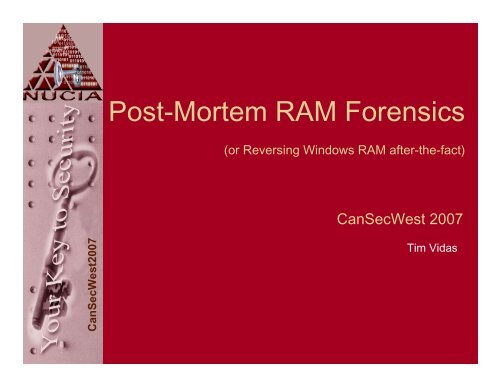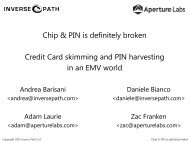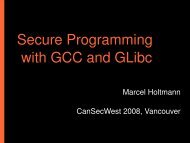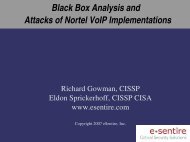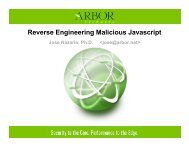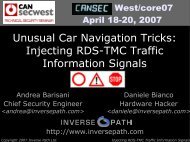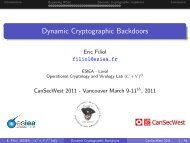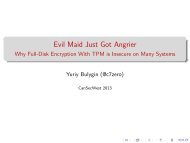Post-Mortem RAM Forensics - CanSecWest
Post-Mortem RAM Forensics - CanSecWest
Post-Mortem RAM Forensics - CanSecWest
You also want an ePaper? Increase the reach of your titles
YUMPU automatically turns print PDFs into web optimized ePapers that Google loves.
<strong>CanSecWest</strong>2007<br />
<strong>Post</strong>-<strong>Mortem</strong> <strong>RAM</strong> <strong>Forensics</strong><br />
(or Reversing Windows <strong>RAM</strong> after-the-fact)<br />
<strong>CanSecWest</strong> 2007<br />
Tim Vidas
<strong>CanSecWest</strong>2007<br />
2<br />
• Tim Vidas<br />
Who am I?<br />
– Research was preformed under<br />
employment by the Nebraska University<br />
Consortium on Information Assurance<br />
(NUCIA) @ the University of Nebraska at<br />
Omaha (UNO)<br />
– Sr. Tech. Research Fellow<br />
– BS and MS in CS<br />
-PhD in the works<br />
– Certs: CISSP, 40xx, Sec+, Guidance, etc.<br />
– Instructor: University, Guidance, LM RRCF<br />
VIDAS
<strong>CanSecWest</strong>2007<br />
3<br />
NUCIA<br />
(obligatory sales pitch slide)<br />
• Nebraska University Consortium on<br />
Information Assurance<br />
• Sits in both CS and MIS programs<br />
• IA full time<br />
• NSA Center of Academic Excellence<br />
• Traditional university coursework in IA,<br />
Crypto, <strong>Forensics</strong>, Secure Administration,<br />
Certification and Accreditation, etc<br />
• STEAL Labs<br />
• “Other work”<br />
VIDAS
<strong>CanSecWest</strong>2007<br />
4<br />
Talk Assumptions<br />
• Only talking about x86 architecture<br />
• Only talking about MS Windows<br />
(nt based)<br />
• Only talking about ‘normal’ setups<br />
(no ‘weird’ boot switches or builds)<br />
VIDAS
<strong>CanSecWest</strong>2007<br />
5<br />
Evidence Volatility<br />
• Registers (more volatile)<br />
• Caches<br />
• Memory, process table, routing<br />
table, arp cache, etc<br />
• Temp file systems<br />
• File system / Disk Block<br />
• Archival Media (less volatile)<br />
Check out RFC 3227:<br />
“Guidance for Evidence Collection and Archiving<br />
VIDAS
<strong>CanSecWest</strong>2007<br />
6<br />
IR: Current Process<br />
• Currently there are two main states<br />
a system could be in at IR time.<br />
• “Dead” System<br />
– Duplicate drives (non-volatile stores)<br />
• “Live” System<br />
–?<br />
Arrive on<br />
Scene<br />
Is System<br />
On?<br />
?<br />
Yes<br />
No<br />
Seize System<br />
/ Copy Drive<br />
VIDAS
<strong>CanSecWest</strong>2007<br />
7<br />
• Live System<br />
Current Process<br />
– Pull the plug<br />
• Better than a ‘shutdown’<br />
– Gather state information<br />
• More common in incident response<br />
• Interact with the machine<br />
– Observing the state changes it<br />
Then, of course, the simple act of observing the outcome<br />
changes it, so the Heisenberg Uncertainty Principle comes<br />
into play here as well. You can't observe the result of an<br />
experiment because the act of observing it changes the<br />
result. Think of the Schrodinger's Cat.<br />
- Professor Farnsworth<br />
VIDAS
<strong>CanSecWest</strong>2007<br />
8<br />
Why copy <strong>RAM</strong><br />
• Drive Encryption<br />
– OneHalf virus<br />
• Completely memory resident malware<br />
– Nimda, SQLslammer<br />
• Recovery of ‘un-reallocated’ space<br />
– Similar to recovery of deleted files.<br />
…but in memory<br />
• Easier than unpacking manually<br />
– In some cases<br />
• The Hacker Defense<br />
• Strings luckiness (of course)<br />
• Why not?<br />
VIDAS
<strong>CanSecWest</strong>2007<br />
9<br />
• Windows<br />
How to copy <strong>RAM</strong><br />
– \.\Physical\Memory (bs=4096)<br />
• All except Server 2003 SP1 +<br />
– \.\DebugMemory anyone?*<br />
–Crash Dump<br />
• Forced?<br />
• Crash on CtrlScrl regkey<br />
• Notmyfault.exe<br />
• DMA through something like Firewire**<br />
• Special hardware (PCI card?)***<br />
*Evidently accessed through [Nt|Zw]SystemDebugControl, also G. Garner Jr says neither<br />
object can access <strong>RAM</strong> fully…<br />
**Proposed, in the firewire spec, but I don’t know how successful (Becher)<br />
***A Hardware Based Memory Acquisition Procedure for Digital Investigations (Carrier, VIDAS Grand )
<strong>CanSecWest</strong>2007<br />
10<br />
Problem<br />
• Volatile stores like <strong>RAM</strong> change<br />
constantly<br />
• Image cannot be validated as it can in the<br />
non-volatile world<br />
– We instead get a “time-sliding view”<br />
– Pre/post md5’s are meaningless as it is<br />
expected that <strong>RAM</strong> will be different by the<br />
time it is compared<br />
– Possibly use something like hash windows to<br />
show that two images made ‘quickley’ are<br />
‘similar’ (or ssdeep…prob not needed)<br />
• The act of creating the copy changes the<br />
state of the machine<br />
• No write blocker installed<br />
VIDAS
T = 0: “Pre” state<br />
T = 1: copy is made<br />
T = 2: “<strong>Post</strong>” state<br />
Objects in the last half<br />
were both removed and<br />
created before being<br />
copied, and an object in<br />
the first half was removed<br />
after it was copied (but<br />
before the copy completed<br />
<strong>CanSecWest</strong>2007<br />
T = 3: copy reflects<br />
neither state<br />
11<br />
Time Sliding Window<br />
VIDAS
<strong>CanSecWest</strong>2007<br />
12<br />
The case for copying<br />
• Even though it is known that<br />
creating the copy changes the<br />
state (ie. creates a new process)<br />
• It creates less impact than<br />
interacting with the machine in<br />
order to gain insight as to the the<br />
current state<br />
VIDAS
<strong>CanSecWest</strong>2007<br />
13<br />
Impact<br />
• If a first responder arrived on<br />
scene and a computer is powered<br />
off, is it considered ‘good practice’<br />
to turn it on?<br />
– Why not?<br />
– Last booted times, file access times,<br />
pagefile, boot time run options<br />
– If it is preferred to not ‘touch’ the disk,<br />
why ‘touch’ <strong>RAM</strong>?<br />
– Lets start moving up the order of<br />
volatility chart<br />
VIDAS
<strong>CanSecWest</strong>2007<br />
14<br />
• systeminfo.exe<br />
• Psinfo<br />
• netstat,<br />
• date,<br />
• Time<br />
• psuptime,<br />
• net statistics<br />
• pulist,<br />
• tlist,<br />
• pslist,<br />
• listdllsdir,<br />
• afind,<br />
• macmatch,<br />
• autoruns,<br />
Minimize impact<br />
• handle,<br />
• pclipnet<br />
• users,<br />
• psloggedon,<br />
• ntlast,<br />
• Dumpusers<br />
• ipconfig,<br />
• fport,<br />
• psservice,<br />
• promiscdetect,<br />
• netstat,<br />
• nbstat,<br />
• net,<br />
• arp<br />
vs<br />
dd<br />
(or similar)<br />
…and the one on the right potentially has more information!!<br />
Nolan, O’Sullivan, Branson, Waits. First Responders Guide to Computer <strong>Forensics</strong>.<br />
Carnegie Mellon University 2005.<br />
VIDAS
<strong>CanSecWest</strong>2007<br />
15<br />
The caveat<br />
• Minimal impact is appealing, but the<br />
information is a requirement<br />
• In order to be acceptable, at least the<br />
same amount of information that is<br />
attainable via interaction, must be<br />
attainable via analysis of the copy of<br />
the volatile–<br />
Information gained:<br />
store FromImageFile >= Interactive Response<br />
– Impact to system:<br />
FromImageCreation
<strong>CanSecWest</strong>2007<br />
16<br />
Analysis<br />
• As the area matures, the analysis of<br />
volatile stores will be able to recreate all<br />
the information regularly attained with all<br />
the previously mentioned commands<br />
• It is essentially a combination of Reverse<br />
Engineering, Kernel Debugging… with a<br />
healthy dose of memory management<br />
and a dash of coding<br />
• Information from non-volatile stores may<br />
be required / helpful to analysis<br />
– Pagefile comparison and/or “unification”<br />
– Another slide on this later on…<br />
VIDAS
<strong>CanSecWest</strong>2007<br />
17<br />
Current Analysis<br />
• Even contemporary analysis (;Login 2005) is<br />
limited to comparing delta’s in a hex editor<br />
and/or parsing for strings)<br />
– I’m not sure I can call the ’05 login article<br />
contemporary any more. There have been an<br />
increasing number of references in the past 18<br />
months. DFRWS, DODCyberCrime, BlackHat, IFIP…<br />
• Samples created as part of my research<br />
showed that even a ‘cleanly’ booted machine<br />
would create 80-120 MB of strings output per 1<br />
GB of <strong>RAM</strong>.<br />
– 100 MB of largely unusable text<br />
– Afhdksoi 1 string<br />
• Better than nothing, but not great by any means<br />
VIDAS
<strong>CanSecWest</strong>2007<br />
18<br />
Proof of Concept<br />
• Recreate the Task Manger from a <strong>RAM</strong><br />
copy<br />
– Look for structures that might have been<br />
processes<br />
• Look for the ‘signature’ of a process<br />
• Discard structures that don’t meet a certain<br />
threshold (which can actually be quite stringent)<br />
• Rules vs recommendations<br />
– Brute force scan: Don’t trust linked list, active<br />
process marker, etc<br />
– Works on an image, dmp style dump,<br />
vmware mem file, etc<br />
– I unimaginatively call this “Process Locator”<br />
or procloc for the easier to type abbreviation<br />
VIDAS
<strong>CanSecWest</strong>2007<br />
19<br />
Proof of Concept<br />
• Many hurdles<br />
– Binary level concepts<br />
– Different OS versions (2k vs XP, sp1<br />
vs sp2) have different offsets into<br />
similar data structures<br />
– Many structures and even data types<br />
require quite a bit of decoding<br />
– Virtual Memory<br />
– Size of samples<br />
– Foundational concepts don’t hold<br />
• <strong>RAM</strong> is not as volatile as one might hope*<br />
* Chow – uhm…a couple years ago? - then repeated as part of this research, short story –<br />
minutes without power plug, depends on hardware<br />
VIDAS
<strong>CanSecWest</strong>2007<br />
20<br />
EPROCESS<br />
• nt!_EPROCESS<br />
• +0x000 Pcb : _KPROCESS<br />
• +0x06c ProcessLock : _EX_PUSH_LOCK<br />
• +0x070 CreateTime : _LARGE_INTEGER<br />
• +0x078 ExitTime : _LARGE_INTEGER<br />
• +0x080 RundownProtect : _EX_RUNDOWN_REF<br />
• +0x084 UniqueProcessId : Ptr32 Void<br />
• +0x088 ActiveProcessLinks : _LIST_ENTRY<br />
• +0x090 QuotaUsage : [3] Uint4B<br />
• +0x09c QuotaPeak : [3] Uint4B<br />
• +0x0a8 CommitCharge : Uint4B<br />
• +0x0ac PeakVirtualSize : Uint4B<br />
• +0x0b0 VirtualSize : Uint4B<br />
• +0x0b4 SessionProcessLinks : _LIST_ENTRY<br />
• +0x0bc DebugPort : Ptr32 Void<br />
etc…etc…<br />
VIDAS
<strong>CanSecWest</strong>2007<br />
21<br />
EPROCESS<br />
• The EPROCESS structure is<br />
fundamental<br />
• Among other information, PID, Creation /<br />
Deletion times, executing image name,<br />
priority, etc<br />
• Used for scheduling<br />
– …well, sort of <br />
• Pointers to previous and next process<br />
(double linked list)<br />
– Not particularly helpful in this case, as ‘rogue’<br />
and ‘old’ processes are desirable to find as<br />
well<br />
VIDAS
<strong>CanSecWest</strong>2007<br />
If it looks like an EProcess…<br />
• Use a debugger like WinDbg (with<br />
LiveKD?) to obtain offsets to parts<br />
of an EProcess (version specific)<br />
+0x070 CreateTime : _LARGE_INTEGER<br />
+0x078 ExitTime : _LARGE_INTEGER<br />
or in a more detail with the same tool as:<br />
+0x070 CreateTime : union _LARGE_INTEGER, 4 elements, 0x8 bytes<br />
+0x000 LowPart : Uint4B<br />
+0x004 HighPart : Int4B<br />
+0x000 u : struct __unnamed, 2 elements, 0x8 bytes<br />
+0x000 LowPart : Uint4B<br />
+0x004 HighPart : Int4B<br />
+0x000 QuadPart : Int8B<br />
+0x078 ExitTime : union _LARGE_INTEGER, 4 elements, 0x8 bytes<br />
+0x000 LowPart 22<br />
+0x004 HighPart<br />
: Uint4B<br />
: Int4B<br />
VIDAS
<strong>CanSecWest</strong>2007<br />
23<br />
…and smells like an EProcess…<br />
• Use these offsets to perform<br />
various checks: (simplified for ppt)<br />
– Except for “IDLE” processes must<br />
have a priority > 0<br />
– Processes must have a page<br />
directory<br />
– All threads must be located in above<br />
the kernel memory bound<br />
– Quantum, workingset max, max #<br />
processes, sync events, etc<br />
VIDAS
<strong>CanSecWest</strong>2007<br />
24<br />
…it must be an EProcess!<br />
• In practice it seems that even a<br />
few number of tests (like about 5)<br />
can produce extremely accurate<br />
results<br />
• This methodology can also be<br />
applied to other structures…<br />
threads are an obvious next step<br />
VIDAS
<strong>CanSecWest</strong>2007<br />
25<br />
Cross Volatility Comparison<br />
• Ideally, the analysis of volatile data stores<br />
can be aided (in practice) by information<br />
gleamed from non-volatile stores<br />
– Pagefile to <strong>RAM</strong> comparison (verification?<br />
Unification?)<br />
• A ‘side effect’ of crash dumps is that the page file is<br />
over written.<br />
• The formation of the DMP file is actually an<br />
interesting process…<br />
– Event log correlation<br />
– What if the disk shows Windows XP, but <strong>RAM</strong><br />
shows Linux structures?<br />
–etc<br />
VIDAS
<strong>CanSecWest</strong>2007<br />
26<br />
EPROCESS<br />
PoC: Process Owner<br />
AccessToken<br />
SID and attributes<br />
SID<br />
This can’t actually be decoded further than SID, because the SID<br />
to “human readable” mapping is not held in <strong>RAM</strong>. This is a prime<br />
example of how information from a non-volatile store may be<br />
needed to aide the volatile analysis (registry, SAM, Domain)<br />
VIDAS
<strong>CanSecWest</strong>2007<br />
27<br />
PoC: Virtual Addressing<br />
• The Process Environment<br />
Block(PEB) is always in the same<br />
place!<br />
– Well, it’s a virtual address, so it’s<br />
‘real’ location needs to be decoded<br />
from virtual to physical using other<br />
values from the structure<br />
VIDAS
<strong>CanSecWest</strong>2007<br />
28<br />
PoC: Virtual Memory<br />
Page Directory Index Page Table Index Byte Offset<br />
Page Directory<br />
PDI Entry<br />
Shown without PAE enabled<br />
Virtual Address<br />
Page Table<br />
PTI Entry<br />
Adapted from Windows Internals : Solomon and Rossinovich<br />
See also Intel Software Developers Manuals<br />
Physical Memory<br />
Page<br />
Physical<br />
Page<br />
Byte<br />
VIDAS
<strong>CanSecWest</strong>2007<br />
29<br />
PoC: FileTime<br />
• 100 nanosecond intervals since 1601<br />
• vs UNIX 1 second intervals since 1970<br />
• and it’s a 64 bit value, stored as two 32<br />
bit values, each lil endian<br />
• # Filetime conversions<br />
• # FFFFFF00 00000000 = under 1.5 seconds<br />
• # 00000001 00000000 = under 1.5 seconds<br />
• # 00000010 00000000 = about 26 seconds<br />
• # 00000000 01000000 = about 7:09<br />
• # 00000000 10000000 = about 1:51:31<br />
• # 00000000 00010000 = about 1 day 6:32:31<br />
• # 00000000 00100000 = about 21 days 8:40:18<br />
• # 00000000 00000100 = about 11 months 22 days 18:44:57<br />
• # 00000000 00001000 = about 14 years 3 months 10 months<br />
11:59:22<br />
• # 00000000 00000001 = about 228 years 5 months 5 days<br />
23:50:03<br />
• # 00000000 00000010 = about 6353 years 6 months 18 days<br />
21:21:00<br />
VIDAS
<strong>CanSecWest</strong>2007<br />
30<br />
PoC: FileTime<br />
• sub Win2Unix4() {<br />
• my $Lval = shift;<br />
• my $Hval = shift;<br />
• my $Time = 0;<br />
• my $Shift = 11644473600; #Shift of time<br />
• if(($Lval == 0) and ($Hval ==0)){<br />
• return $Time;<br />
• }else{<br />
• $Time = int(($Hval * 2**32 / 10000000) + ($Lval / 10000000));<br />
• $Time -= $Shift;<br />
• }<br />
• if ($Time < 0){<br />
• $Time = 0;<br />
• }<br />
• return $Time;<br />
• }<br />
Actually not that much code!<br />
VIDAS
<strong>CanSecWest</strong>2007<br />
31<br />
• Create Images<br />
C<br />
–ddexample<br />
PoC: Demo<br />
• trusted binary’ (live CD, statically linked)<br />
• external Mass storage container<br />
• ‘raw’ type<br />
– Forced Crash condition<br />
• registry keys<br />
• 3rd party testing tool<br />
• External Mass storage container<br />
• proprietary DMP format created on reboot<br />
• Use PERL to parse through a ton of data<br />
– Practical Extraction and Reporting Language<br />
VIDAS
<strong>CanSecWest</strong>2007<br />
32<br />
PoC: Demo<br />
• Images created from cleanly installed<br />
OSes<br />
– Only video/network drivers<br />
• IBM MPro machine(s) with 512 MB <strong>RAM</strong><br />
(turned off for 15 minutes)<br />
• Helix 1.7 CD inserted and physical<br />
memory is imaged (if possible)<br />
• Registry keys created to set crashdump to<br />
‘on’ and ‘full’<br />
• Nonmyfault.exe used to forced system<br />
crash and thus a crash-dump style image<br />
• Considering posting test images publicly…<br />
VIDAS
<strong>CanSecWest</strong>2007<br />
33<br />
PoC: Demo<br />
• On a removable hard drive<br />
– raw style captures via helix dd<br />
– Crash style captures via<br />
nonmyfault.exe & crashdump<br />
• Just typical PERL<br />
– Activestate<br />
– Cross platform<br />
• The idea is to replicate as much or<br />
more information that Windows<br />
Task Manager<br />
VIDAS
<strong>CanSecWest</strong>2007<br />
34<br />
• Ready….go!<br />
PoC: Demo<br />
– MEMORY.DMP format<br />
– dd –style<br />
– Processes<br />
– Threads<br />
– Exe extraction<br />
• Virtual memory layer required<br />
• Finished coding this during Adam<br />
Laurie’s talk yesterday – consider BETA<br />
VIDAS
<strong>CanSecWest</strong>2007<br />
35<br />
PoC: Demo<br />
• SO…given that the demo was<br />
successful<br />
– We saw that it is possibly to get as<br />
much (or more) information postincident<br />
while cause as much (or<br />
less) impact to the system<br />
• OR if it wasn’t successful<br />
– We _should_ have seen the above ;-)<br />
VIDAS
<strong>CanSecWest</strong>2007<br />
36<br />
Goals met<br />
• Information requirement<br />
– pslist > taskmanager<br />
– procloc ~= pslist<br />
VIDAS
<strong>CanSecWest</strong>2007<br />
37<br />
Future work<br />
(process specific)<br />
• Compare the Brute force list to a list<br />
obtained by walking the list<br />
– ‘cross view diff’ off the untrusted list with the<br />
‘more trusted’ list – red flags<br />
• “unification of virtual memory”<br />
– Swap all pages ‘in’ kinda, then defrag it?!<br />
• Good, OS version auto detection<br />
• Automate correlation with other sources<br />
of information<br />
– If you supply a Registry hive, auto process<br />
owner from SID<br />
• Automatically and/or selectively extract<br />
executables<br />
VIDAS
<strong>CanSecWest</strong>2007<br />
38<br />
Future work<br />
(process specific)<br />
• Flag processes/threads that aren’t<br />
“playing by the rules”<br />
– Window title, path, pointers, parent, etc<br />
• Follow the entire tree<br />
– Attribute every thread to a process, every<br />
page to what allocated it, parent/child<br />
link…etc. Then what’s left?<br />
• Support the /PAE and /3G boot switches<br />
• Vista support (right now, parsing looks to<br />
be easy, acquisition looks to be hard)<br />
• Non i386 support<br />
• Parsing from within EnCase?<br />
VIDAS
<strong>CanSecWest</strong>2007<br />
39<br />
Future work<br />
(memory, not process specific)<br />
• File cache<br />
– Delayed write to disk, usually for<br />
priority reasons<br />
• Network connections<br />
– Tied to processes<br />
• Video card?<br />
– Some malware is executing directly<br />
from video card memory<br />
VIDAS
<strong>CanSecWest</strong>2007<br />
40<br />
Future Setbacks<br />
(perceived – opinion)<br />
• Malware that manipulates acquisition<br />
– There are about 3 non-hardware ways to acquire,<br />
trivial to ‘hook’ these and hide during acquisition (of a<br />
live non-rebooted machine)<br />
– Not deny access, simply modify output – similar to<br />
techniques used in rootkits today to hide – processes<br />
from task manager, etc<br />
• Microsoft will continue to make it more and more<br />
difficult to get to ‘RAW’ <strong>RAM</strong><br />
– Restriction to objects<br />
– Other things like VISTA’s randomization<br />
• <strong>RAM</strong> becomes even more scattered that the<br />
current memory model<br />
– Like VISTA’s <strong>RAM</strong> extender (USB) – ReadyBoost<br />
• New architectures<br />
VIDAS
<strong>CanSecWest</strong>2007<br />
41<br />
Food for thought:<br />
• But the cases I have don’t require<br />
all this stuff!<br />
– The hacker defense will bear it’s face<br />
eventually<br />
– <strong>RAM</strong> imaging is going to be ‘industry<br />
standard’ it’s just a matter of time<br />
– You may be more likely to have a<br />
Rootkit that you think*<br />
*You’ve heard of Sony right?<br />
VIDAS
<strong>CanSecWest</strong>2007<br />
42<br />
Google starters<br />
(in no real order)<br />
• PhysicalMemory object<br />
• MyFip.H<br />
• Fanbot.A<br />
• DKom<br />
• Hacker Defender<br />
• Shadow Walker<br />
• EProcess<br />
• The artist formerly called Sysinternals<br />
(process explorer for starters)<br />
• “Blue Pill” + rootkit<br />
• UPX<br />
• Packer<br />
• Sony Rootkit<br />
• RAIDE<br />
• TRUMAN<br />
• Shimmer.a<br />
• Tim Vidas ☺<br />
• Mariusz Burdach<br />
• Jesse Kornblum<br />
• Andreas Schuster<br />
• Aaron Walters<br />
• Nick Petroni<br />
• Harlan Carvey<br />
• ProcLoc<br />
• Volatools<br />
• WMFT<br />
• PTFinder<br />
• LSPI<br />
• Memparse<br />
VIDAS
<strong>CanSecWest</strong>2007<br />
43<br />
Question #1 from the<br />
Audience<br />
• So how do you recommend that I<br />
implement <strong>RAM</strong> into my investigations?<br />
– Officially I’m probably not supposed to<br />
answer that<br />
• The whole I’m not a lawyer and don’t play one on<br />
TV thing<br />
• The whole I’m an Academic not a practitioner thing<br />
– That said: If the situation allows, maybe the<br />
best way is to:<br />
• arrive on scene<br />
• get ready (BIOS cheat sheet, dd on bootable CD)<br />
• pull plug ***<br />
• plug back in immediately ***<br />
• boot to CD<br />
• copy <strong>RAM</strong><br />
• image disk as normal<br />
• take both back with you<br />
***Or maybe it’s via dd on a USB mass storage – copy w/o unplugging, time / results VIDAS will tell
<strong>CanSecWest</strong>2007<br />
44<br />
Other Questions?<br />
• Contact info<br />
– I’ve got a bunch of cool <strong>CanSecWest</strong><br />
meishi (business cards)<br />
• Source Code<br />
– Completely FREE<br />
–GPL<br />
– Perl is available on the net already<br />
– C is available right now (come and<br />
get it). It will be available on the net<br />
after I clean it up a bit.<br />
VIDAS
<strong>CanSecWest</strong>2007<br />
45<br />
Cited<br />
• Windows Internals, Russinovich /<br />
Solomon<br />
• Intel 64 and IA-32 Architectural<br />
Software Developers Manuals<br />
– PDFs are online<br />
– Dead Tree copies are FREE<br />
• Rootkits, Hogland / Butler<br />
• Reversing, Eilam<br />
• And the papers/documents footnoted in<br />
the slides<br />
VIDAS


